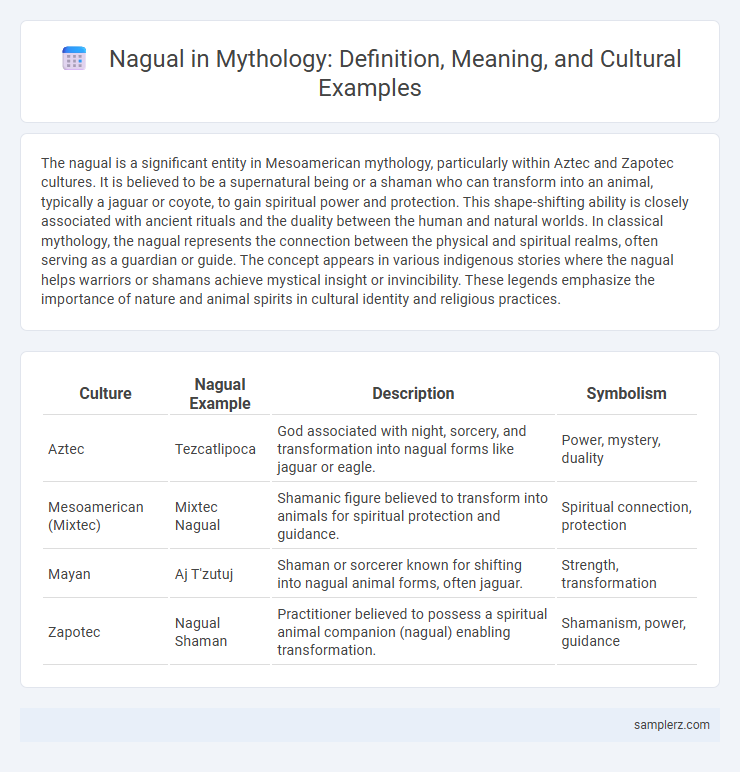The nagual is a significant entity in Mesoamerican mythology, particularly within Aztec and Zapotec cultures. It is believed to be a supernatural being or a shaman who can transform into an animal, typically a jaguar or coyote, to gain spiritual power and protection. This shape-shifting ability is closely associated with ancient rituals and the duality between the human and natural worlds. In classical mythology, the nagual represents the connection between the physical and spiritual realms, often serving as a guardian or guide. The concept appears in various indigenous stories where the nagual helps warriors or shamans achieve mystical insight or invincibility. These legends emphasize the importance of nature and animal spirits in cultural identity and religious practices.
Table of Comparison
| Culture | Nagual Example | Description | Symbolism |
|---|---|---|---|
| Aztec | Tezcatlipoca | God associated with night, sorcery, and transformation into nagual forms like jaguar or eagle. | Power, mystery, duality |
| Mesoamerican (Mixtec) | Mixtec Nagual | Shamanic figure believed to transform into animals for spiritual protection and guidance. | Spiritual connection, protection |
| Mayan | Aj T'zutuj | Shaman or sorcerer known for shifting into nagual animal forms, often jaguar. | Strength, transformation |
| Zapotec | Nagual Shaman | Practitioner believed to possess a spiritual animal companion (nagual) enabling transformation. | Shamanism, power, guidance |
Origins of the Nagual in Mesoamerican Beliefs
The nagual originates from ancient Mesoamerican beliefs where it is considered a spiritual companion or alter ego, often manifesting as an animal with supernatural powers. This concept is deeply rooted in the cosmology of the Aztec and Maya civilizations, who believed that shamans or sorcerers could transform into their nagual to access spiritual realms or gain protection. The nagual symbolizes a profound connection between humans and nature, reflecting the Mesoamerican understanding of identity and transformation.
How Naguals Are Portrayed in Aztec Mythology
Naguals in Aztec mythology are depicted as powerful shapeshifters capable of transforming into animals such as jaguars or eagles, embodying a direct connection between humans and the spiritual realm. These entities often serve as protectors or guides for warriors and shamans, symbolizing strength, wisdom, and transformation. The portrayal emphasizes the cultural belief in the fluid boundary between human and animal forms, reflecting the Aztecs' deep reverence for nature and supernatural forces.
Naguals and Their Connection to Toltec Legends
Naguals are shape-shifting beings in Toltec mythology, often depicted as humans who can transform into animals like jaguars or eagles, symbolizing spiritual power and transformation. These mystical figures serve as guides and protectors, bridging the physical and spirit worlds according to ancient Toltec legends. Their enduring presence in folklore highlights the deep cultural belief in personal and cosmic transformation within Mesoamerican traditions.
Shapeshifting: The Core Power of the Nagual
Nagual, a central figure in Mesoamerican mythology, embodies the power of shapeshifting, transforming seamlessly from human to animal forms, often into jaguars, birds, or coyotes. This core ability symbolizes a deep spiritual connection to nature and serves as a bridge between the physical and supernatural realms. The nagual's shapeshifting power grants not only physical transformation but also spiritual insight and protection within indigenous cultural narratives.
Naguals in Mixtec and Zapotec Folklore
Naguals in Mixtec and Zapotec folklore are shapeshifters believed to possess the ability to transform into animals such as jaguars, owls, or coyotes, embodying spiritual guides and protectors. These entities serve as intermediaries between the human and supernatural worlds, often linked to sorcerers or shamans who harness their power for healing, protection, and mystical knowledge. The cultural significance of naguals is reflected in traditional rituals and oral histories, emphasizing their role in maintaining the balance between natural and spiritual realms within Oaxacan indigenous communities.
Symbolic Animals Associated with Naguals
Naguals in Mesoamerican mythology are often linked to symbolic animals such as jaguars, coyotes, and eagles, which represent their spiritual power and shape-shifting abilities. The jaguar symbolizes strength and nocturnal dominance, while the eagle signifies vision and connection to the divine. These animals embody the transformative essence of naguals, serving as spiritual guides and protectors in indigenous cultural beliefs.
Naguals Versus Other Mythical Shapeshifters Worldwide
Naguals, central to Mesoamerican mythology, represent human sorcerers capable of transforming into animal forms, serving as spiritual guides or protectors. Unlike werewolves in European legends, who often involuntarily transform under a full moon, Nagual transformations are controlled and deeply connected to personal or community identity. This distinction highlights the cultural significance of shapeshifting in indigenous traditions, where Naguals embody a harmonious link between humans and nature, contrasting with often fear-driven narratives in other mythologies.
Representation of Naguals in Modern Mexican Culture
Naguals in modern Mexican culture frequently symbolize the connection between humans and the spiritual world, often depicted as shapeshifters embodying animals such as jaguars or coyotes. These representations appear in contemporary art, literature, and popular media, highlighting indigenous beliefs and emphasizing themes of transformation and duality. Naguals serve as powerful cultural icons that preserve and revitalize pre-Hispanic mythologies within Mexico's evolving identity.
Naguals in Oral Traditions and Storytelling
Naguals in oral traditions are mystical beings believed to possess the power to transform into animals or assume spiritual forms, symbolizing a deep connection between humans and nature. These figures frequently appear in Mesoamerican mythology, especially among the Aztec and Zapotec cultures, where they serve as protectors, guides, or shapeshifting sorcerers in folk tales and legends. Stories about naguals emphasize themes of transformation, spiritual duality, and the blurred boundaries between the physical and supernatural worlds.
Naguals as Spiritual Guides and Protectors
Naguals in mythology serve as powerful spiritual guides and protectors, believed to possess the ability to transform into animal forms, embodying wisdom and supernatural strength. These entities function as intermediaries between the physical and spiritual worlds, offering guidance, protection, and insight to their human counterparts. In Mesoamerican traditions, Naguals are revered for their role in safeguarding communities and leading shamans through mystical journeys.

example of nagual in mythology Infographic
 samplerz.com
samplerz.com